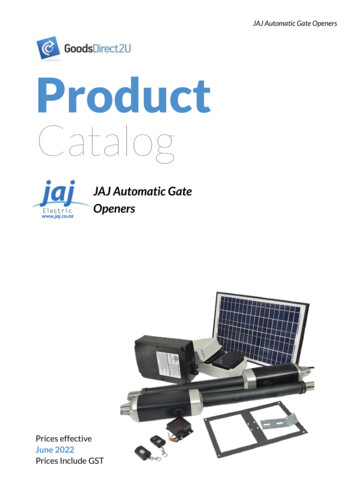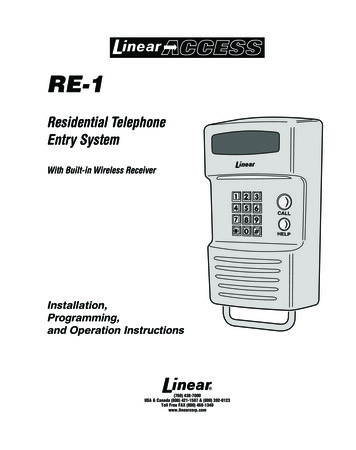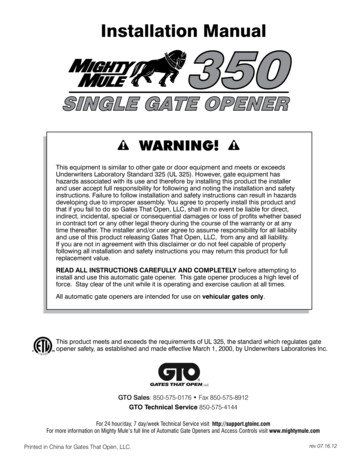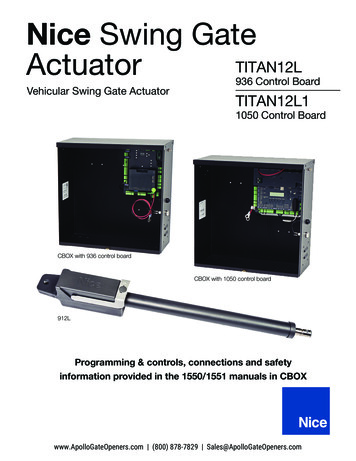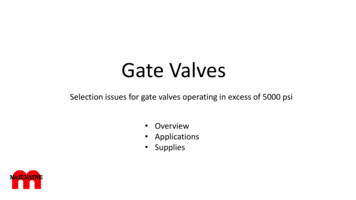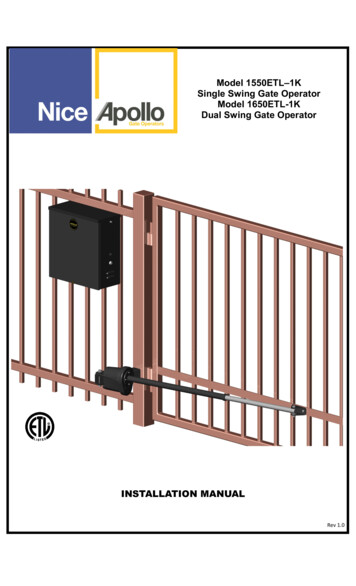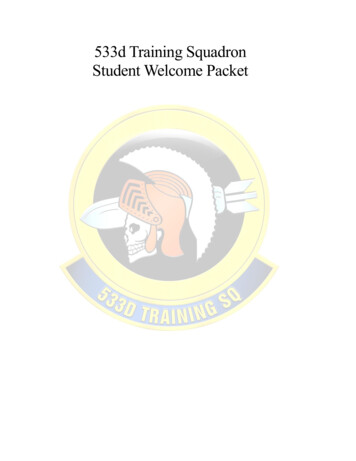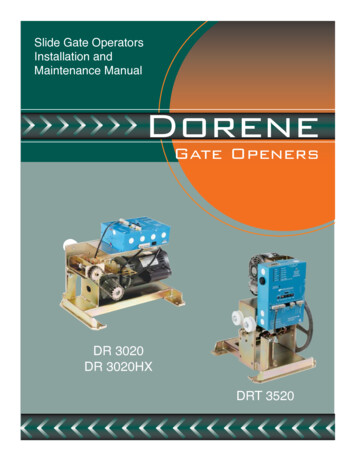
Transcription
Slide Gate OperatorsInstallation andMaintenance ManualDoreneGate OpenersDR 3020DR 3020HXDRT 3520
Table of ContentsJS10. . . . . . . . . . . . . . . . . . . . . . . . . . . . . . . . . . . . . . . . . . . . . . 18Important Installation InstructionsDS4020/DS 4020H/DS & 4020HX (only) Gate operation. . . . . 6Jp4. . . . . . . . . . . . . . . . . . . . . . . . . . . . . . . . . . . . . . . . . . . . . . . 18General Safety Instructions. . . . . . . . . . . . . . . . . . . . . . . . . . . . . 3Pad and Operator Location. . . . . . . . . . . . . . . . . . . . . . . . . . . . . 6Important Installation Instructions for the DST 4520 0nly. . . . . 8Gate operation. . . . . . . . . . . . . . . . . . . . . . . . . . . . . . . . . . . . . . . 8Pad and Operator Location. . . . . . . . . . . . . . . . . . . . . . . . . . . . . 8Concrete Pad Construction and Layout . . . . . . . . . . . . . . . . . . . 9Operator Mounting. . . . . . . . . . . . . . . . . . . . . . . . . . . . . . . . . . . 9Universal gate arm Installation Guidelines. . . . . . . . . . . . . . . . 10Arm Installation . . . . . . . . . . . . . . . . . . . . . . . . . . . . . . . . . . . . 10Initial Limit Adjustment. . . . . . . . . . . . . . . . . . . . . . . . . . . . . . 11Pipe Connection . . . . . . . . . . . . . . . . . . . . . . . . . . . . . . . . . . . . 11Dorene DGC2000 Controller. . . . . . . . . . . . . . . . . . . . . . . . . . 12Power Connection / Electrical Hookup115Volt Single Phase . . . . . . . . . . . . . . . . . . . . . . . . . . . . . . . . . . . 12Mag-Lock installation . . . . . . . . . . . . . . . . . . . . . . . . . . . . . . . 13Final Limit Adjustment. . . . . . . . . . . . . . . . . . . . . . . . . . . . . . . 14DGC – 2000 Controller Settings. . . . . . . . . . . . . . . . . . . . . . . . 14Hand. . . . . . . . . . . . . . . . . . . . . . . . . . . . . . . . . . . . . . . . . . . . . 14Close Timer. . . . . . . . . . . . . . . . . . . . . . . . . . . . . . . . . . . . . . . . 14Reverse Delay. . . . . . . . . . . . . . . . . . . . . . . . . . . . . . . . . . . . . . 14Close Delay. . . . . . . . . . . . . . . . . . . . . . . . . . . . . . . . . . . . . . . . 15Motor Run Timer . . . . . . . . . . . . . . . . . . . . . . . . . . . . . . . . . . . 15Sensitivity Adjustment . . . . . . . . . . . . . . . . . . . . . . . . . . . . . . . 15Warning Alarm. . . . . . . . . . . . . . . . . . . . . . . . . . . . . . . . . . . . . 15To Hold Gate Open . . . . . . . . . . . . . . . . . . . . . . . . . . . . . . . . . 16JP-3. . . . . . . . . . . . . . . . . . . . . . . . . . . . . . . . . . . . . . . . . . . . . . 16Led enable switch. . . . . . . . . . . . . . . . . . . . . . . . . . . . . . . . . . . 16Final Assembly. . . . . . . . . . . . . . . . . . . . . . . . . . . . . . . . . . . . . 16Blue Box (DGC 2000 ) format All Commands are dry contact,except JS4 & JS8. . . . . . . . . . . . . . . . . . . . . . . . . . . . . . . 17JS1. . . . . . . . . . . . . . . . . . . . . . . . . . . . . . . . . . . . . . . . . . . . . . . 17JS2. . . . . . . . . . . . . . . . . . . . . . . . . . . . . . . . . . . . . . . . . . . . . . . 17JS3. . . . . . . . . . . . . . . . . . . . . . . . . . . . . . . . . . . . . . . . . . . . . . . 17JS4. . . . . . . . . . . . . . . . . . . . . . . . . . . . . . . . . . . . . . . . . . . . . . . 17JS5. . . . . . . . . . . . . . . . . . . . . . . . . . . . . . . . . . . . . . . . . . . . . . . 17JS6. . . . . . . . . . . . . . . . . . . . . . . . . . . . . . . . . . . . . . . . . . . . . . . 17JS7. . . . . . . . . . . . . . . . . . . . . . . . . . . . . . . . . . . . . . . . . . . . . . . 17JS8. . . . . . . . . . . . . . . . . . . . . . . . . . . . . . . . . . . . . . . . . . . . . . . 18JS9. . . . . . . . . . . . . . . . . . . . . . . . . . . . . . . . . . . . . . . . . . . . . . . 182Jp3. . . . . . . . . . . . . . . . . . . . . . . . . . . . . . . . . . . . . . . . . . . . . . . 18Shadow loop Installation. . . . . . . . . . . . . . . . . . . . . . . . . . . . . . 18Synchronous Open/Close Operation DGC 2000 . . . . . . . . . . . 19Double Swing gate loop placement . . . . . . . . . . . . . . . . . . . . . 21Final Check. . . . . . . . . . . . . . . . . . . . . . . . . . . . . . . . . . . . . . . . 22Maintenance. . . . . . . . . . . . . . . . . . . . . . . . . . . . . . . . . . . . . . . 22Safety Accessories . . . . . . . . . . . . . . . . . . . . . . . . . . . . . . . . . . 22Installation. . . . . . . . . . . . . . . . . . . . . . . . . . . . . . . . . . . . . . . . . 22Testing. . . . . . . . . . . . . . . . . . . . . . . . . . . . . . . . . . . . . . . . . . . . 22Warning. . . . . . . . . . . . . . . . . . . . . . . . . . . . . . . . . . . . . . . . . . . 22Caution. . . . . . . . . . . . . . . . . . . . . . . . . . . . . . . . . . . . . . . . . . . 22Troubleshooting . . . . . . . . . . . . . . . . . . . . . . . . . . . . . . . . . . . . 23The left LED’S. . . . . . . . . . . . . . . . . . . . . . . . . . . . . . . . . . . . . 23The Right LED’s. . . . . . . . . . . . . . . . . . . . . . . . . . . . . . . . . . . . 23Gate will not open or operate. . . . . . . . . . . . . . . . . . . . . . . . . . 23LIMITED WARRANTY SUMMARY(For Normal Wear and Tear)DoreneL.L.C warrants all gate openers to be free of defects inmaterial & workmanship for a period of 4 years for commercialuse and 6 years for residential use, i.e. single residence, from dateof purchase. Any mechanical part or parts found defective withinthis period, at the manufacturer’s option, shall be repaired orreplaced free of charge.FOB our factory.The above warranty is in lieu of all other warranties expressedor implied and shall be void in cases of acts of God, vandalism,improper installation or improper maintenance.The electronics are warranted for a period of 2 years under thesame requirements.
General Safety InformationRead through the installation instructions completely beforebeginning installation, and then perform them in the order givenIMPORTANT SAFETY INSTRUCTIONSWarning: To reduce the risk of injury or death1. Read and follow all instruction carefully.2. Never let children operate or play with gate controls. Keep the remote control away from children.3. Always keep people and objects away from the gate. No one should cross the path of a moving gate.4. Test the gate operator monthly. The gate MUST reverse on contact with a rigid object or stop when anobject activates the non-contact sensors. After adjusting the force or the limit of travel, retest the gateoperator. Failure to adjust and retest the gate operator properly can increase the risk of injury or death.5. Use the emergency release only when the gate is not moving.6. Keep gate properly maintained. Read the owner’s manual. Have a qualified service person makerepairs to gate hardware.7. The entrance is for vehicles only. Pedestrians must use separate entrance.8. Save these instructions.For gate operators utilizing a Non-Contact Sensor1. See Manufacturers instructions on the placement of non-contact sensors for each type of application.2. Care shall be exercised to reduce the risk of nuisance tripping, such as when a vehicle, trips the sensorwhile the gate is still moving.3. One or more non-contact sensors shall be located where the risk of entrapment or obstruction exists,such as the perimeter reachable by a moving gate or barrier.For gate operators utilizing a Contact Sensor1. One or more contact sensors shall be located at the leading edge, trailing edge, and post mounted bothinside and outside of a vehicular horizontal slide gate.2. A hard wired contact sensor shall be located, and it’s wiring arranged, so that the communication betweenthe sensor and the gate operator is not subjected to mechanical damage.3. A wireless contact sensor such as one that transmits radio frequency (RF) signals to the gate operator forentrapment protection functions shall be located where the transmission of the signals are not obstructed orimpeded by building structures, natural landscaping or similar obstruction. A wireless contact sensor shallfunction under the intended end-use conditions.3
Install the gate operator only when:1. The operator is appropriate for the construction of the gate and the usage class of the gate.2. All openings of a horizontal slide gate are guarded or screened from the bottom of the gate to a3. Minimum of 4’ (1.2m) above the ground to prevent a 2.25” (57.15mm) diameter sphere from passingthrough the openings anywhere in the gate, and in that portion of the adjacent fence that the gatecovers in the open position.4. All exposed pinch points are eliminated or guarded5. Guarding is supplied for exposed rollersThe operator is intended for installation only on gates used for vehicles. Pedestrians must be suppliedwith a separate access opening.The gate must be installed in a location so that enough clearance is supplied between the gate andadjacent structures when opening and closing to reduce the risk of entrapment. Swinging gates shallnot open into public access areas.The gate must be properly installed and work freely in both directions prior to the installation of the gateoperator. Do not over-tighten the operator clutch or pressure relief valve to compensate for a damaged gate6. For gate operator utilizing type D protection7. The gate operator controls must be placed so that the user has full view of the gate area when the gateis moving. The placard as required by 52a.1.6 shall be placed adjacent to the controls8. An automatic closing device (such as a timer, loop sensor, or similar device) shall not be employed.No other activation device shall be connected.9. Controls must be far enough from the gate so that the user is prevented from coming in contact with thegate while operating the controls. Controls intended to be used to reset an operator after two sequentialactivations of the entrapment protection device or devices must be located in the line-of-sight of the gate.All warning signs and placards must be installed where visible in the area of the gate.4
Gate operatorUsage ClassHorizontal SlideSwingVehicular I and IIAB1, B2, or DA or CA, B1, C or DVehicular IIIA, B1, or B2A, B1, B2, D or EA, B1 or CA, B1, C, D or EVehicular IVA, B1, B2, or DA, B1, B2, D or EA, B1, C or DA, B1, C, D or ENote:The same type of device shall not be utilized for both the primary and the secondary entrapmentprotection means. Use of a single device to cover both the opening and closing directions is inaccordance with the requirement; however, a single device is not required to cover both directions.A combination of one type B1 for one direction and one type B2 for the other direction is theequivalent of one device for the purpose of complying with the requirements of either the primaryor secondary entrapment protections means.Entrapment protection types:Type AInherent entrapment sensing system.Type B1Provision for connection of, or supplied with, a non-contact sensor (photoelectricsensor or the equivalent).Type B2Provision for connection of, or supplied with, a contact sensor (edge device orthe equivalent).Type CInherent adjustable clutch or pressure relief device.Type DProvision for connection of, or supplied with, an actuating device requiring continuouspressure to maintain opening or closing motion of the gate.Type EAn inherent audio alarm.5
Important Installation InstructionsDr 3020/DR 3020HX/DRT 3520Gate operationThe gate must roll freely with no binding of the wheel, guides, and/or gate hardware before any operator isconnected to the gate.Pad and Operator LocationPosition the pad as indicated in Figure #1. Failure to do so may cause erratic operation resulting in reducedoperator life.Important:If the gate is not at least twenty-eight inches longer than the opening, an extension should be addedto the rear portion of the gate fir the mounting of the rear chain bolt bracket. See Fig #2 Theextension must be rigid and long enough to allow the gate to fully close without the rear chain boltbracket hitting the operator.Note:If there is already concrete where the operator is to be mounted, a pad is not necessary, if the existingconcrete is level.1”Gate Open PositionConcrete Pad 4”Gate Closed PositionDR 3020 / DR 3020HX / DRT3520Figure 1 (Front Mount)Concrete Pad Construction and LayoutElectrical Stub Ups18” Min.YFigure 2 (Side View)Y dimension in Figure 2 must be high enough so that water will not stand under the operator in a worst casescenario. Soil conditions may vary but in sandy or loose soil the pad should be at least 18”-24” inches deep.6
Concrete pad Construction and LayoutThe gate must roll freely with no binding of the wheel, guides, and/or gate hardware before any operator isconnected to the gate.DR3020/DR3020HXWallGate1 ical Stub Up Area4”10”20” - Mounting Holes22” - Cover Size26” Pad Size MinimumFigure 3 (Top View)DR 3020 / DR 3020HX13”OperatorFigure 4 (Front Mount)7
Concrete pad Construction and LayoutThe gate must roll freely with no binding of the wheel, guides, and/or gate hardware before any operator isconnected to the gate.DRT3520WallGate1 4”61/4”20”14”111/2”Electrical StubUp Area21/2”11/2”Chain4 41/2” 23/4”123/4” - Mounting Holes16” - Cover Size24” Pad Size MinimumFigure 5 (Top View)DRT 352010”Operator8Figure 6 (Front Mount)
Mechanical hook up (Front mount)Position the pad as indicated in Figure #1. Failure to do so may cause erratic operation resulting in reducedoperator life.1. Clamp both chain bolt brackets to the gate as in Figure 2, with the hole in each of the brackets lining up withthe operator idler sprocket, vertically and horizontally. Weld in placeImportant:Failure to line up brackets properly will result in premature idler and guide wear and may cause thechain to jump off the sprocket.2. Connect the longer chain bolt to the chain and the rear chain bolt bracket, with room for adjustment.3. Route the chain through the operator so that the drive sprocket has maximum tooth contact. See Figure #24. Fasten the shorter chain to the front chain bolt and tighten the nuts so that the end of the chain bolt is awayfrom the chain flush with the nut.5. Hold the gate and extend the chain to the front of the chain bolt.6. Cut the chain to the proper length and fasten to the front of chain bolt with the master link supplied.7. Adjust the chain by tightening the rear chain bolt until slack is about two or three inches for every ten feet ofchain.8. Tighten the rear chain bolt nuts.Note:Excessive tightening of the chain will reduce bearing life.Note:Hand of operator is the same for rear mount if driving the gate off the bottom of the drive sprocket/This is, however reverse if the driving the gate off the top of the drive sprocket.Operator MountingLocate the operator on the concrete pad per figure #4 and fasten to the pad using 3/8 x 1-7/8 or longer concreteanchors.DR 3020 / DR 3020HX / DRT3520OperatorFigure 7 (Rear Mount)9
Initial Limit Adjustment1. Remove limit nut keeper2. Move the gate to the fully open position, minus one foot3. Adjust the open limit nut until the open limit switch just activates.4. Replace the limit nut keeper.Important:Do not let the close limit nut go past the close limit switch when performing step #5.5. Move the gate to the fully closed position, minus one foot6. Adjust the close limit nut until the close limit switch just activates.Figure 8 (Top View)Figure 9 (Side View)Note: The hand of the operator is easily identified after the operator is hooked up electrically by activating on ofthe limit switches, which will illuminate the open or close limit switch LED. Hand is very easily altered by the handchange switch. See Fig #7 for location of the switch.10
Dorene DGC2000 Controller11
Power Connection / Electrical HookupImportant: Turn power OFF at the breaker before making any connections or adjustments.Note:Port 1, 2, 11 and 12 are not to used. They are empty ports.The operator should be on a separate line with a 15 AMP breaker. Supply voltage must be within10% of the operator rating under load conditions. Connect power in accordance with local codesAll operations must be properly grounded with a supply grounding conductorNote:Master Slave installations must have the same phase power when separate breakers are used115 Volt Single PhaseSee figure 11#12 OR #14 gauge shielded, standard wire is recommended for the high voltage hoop-ups.1. Secure the 115 volt single phase HOT line to port #102. Secure ground supply line to port #93. Secure neutral supply line to port #8Important: Turn power OFF before making any connections or adjustments.Mag-Lock installationIf a 115 volt lock is used, connect the neutral wire from the lock to port #7 and the power wire from thelock to port #6DeadHighVoltageInMag LockWiresMotorWiresDead1212Dead11Dead10L-1 (hot) (117 VAC) input only9Ground (117 VAC) input only8Neutral (117 VAC) input only7Neutral6Lock5White - Motor Wire4Red - Motor Wire3Yellow - Motor Wire2Dead1DeadFigure 11 (Power Connection)
Clutch AdjustmentImportant:Always turn power off before making any adjustment.1. Remove the two set screws in the clutch adjuster nut.2. Using a 1 ¼” Open-end wrench (available at the factory) tighten the clutch adjuster nut until proper tensionis achieved. (See Note below) Try just a ¼ turn at a time and then test. DO NOT USE A PIPE WRENCH ORCHANNEL LOCKS TO ADJUST THE CLUTCH!.Important:Do not over tighten the clutch! Gear damage may result voiding the warranty!Note:The clutch must be sufficiently tight so that it does not slip in normal operation and so that the motorand the current sensor “feel” a load when the gate is obstructed.3. After the clutch is properly adjusted, with power OFF, tighten the two set screws in the clutch adjuster nut.Final Limit AdjustmentIt is possible that a final adjustment may be required for the arm to stop exactly as desired. In the open position,the swing arms and the pipe arm should be doubled on the top of each other. On CLOSE the motor shouldturn off before the arm hits the stop so that it coasts to the stop. If the operation is not as described, adjust theposition of the limit collar to correct the error.DGC – 2000 Controller Settings HandThis switch changes the direction the motor runs to open the gate, left or rightClose TimerThis switch is used to activate (on) or deactivate (off) the automatic close timer. The gate willclose after a specified time as set under Close Delay if this switch is ON unless the gate isbeing held open by an accessory.Brake Delay (for slide gates only)This set of switches determines the length of time between the motor turning off and theelectronic brake coming on. All switches should be ON except for a gate on an incline.Reverse DelayThis set of switches is to prevent instant reversal of the motor to reduce operator/gate stressand to prevent operator malfunction. Note: Never put all of these switches in the OFF position asoperator damage may result.13
Close DelayIf the close time is switched into the circuit, this set of switches adjuststhe length of time the gate stays open before closing automatically. For example,if you want 45 second you would turn on 32 8 4 1 45 as illustrated below in figure 12.32 16 8 4 2 1ONOFFFigure 12Motor Run TimerThis timer should be set at least 10 seconds or longer than the normal operating time, andwill stop the gate if for some reason the motor runs longer than the switch setting. If thishappens the stop LED will flash 3 times then pause, 3 times then pause, it will continue toflash until power has been turned off.Sensitivity AdjustmentThis is used to adjust the current level at which the gate will respond to anobstruction. Turn clock-wise for more sensitive and counter clock-wise for lesssensitive.Caution:The current sense feature is designed only to protect the operator andreduce vehicle damage. It is not intended for pedestrian traffic!Note:The setting must always be sensitive enough to respond to anobstruction, but not so sensitive that it responds without obstruction.Warning AlarmOne to three seconds prior to gate movement.14
To Hold Gate OpenWire switch to stop prior to full open to close reverse switch and press transmitter to restart.JP-3Anti-tailgate feature. See Figure #6 on page 11Led enable switchThe two rows of LED’s, located in the upper left hand corner of theDGC 3000, Functions for thirty minutes from power-up and turns offautomatically to save power. To verify the LED’s are enabled, activate a limitswitch momentarily. If the corresponding LED does not light, press theLED enable button, located below the 2 rows of LED’s, to turn on the LED’sfor another 30 minutes.Safety is for secondary entrapment – devices connected to this terminal will cause the gate to stop andreverse 3”. The gate must be activated by a person to move after this has occurred.Pulse Open/Pulse Close terminal is used to both open and close the gate from a single button. Activation of thebutton will open the gate unless the gate is fully open in which case it will close the gate.24V Power terminal is one leg of 24 VAC power (COMMON is the other side of 24 VAC power, and isgrounded), which can be used to power a radio receiver, digital keypad or other accessory with 24 VAC voltagerequirements.Important: This terminal must not be grounded at any time even through any controls which will be used toactivate the gate!Final Assembly1. Operate the gate to the middle of its operation and turn power OFF at the breaker (this prevents activation ofthe operator during final assembly). If preferred, you may turn power OFF and back ON at the operator, theoperator will not move until activated.2. Remove the arm by removing the stainless steel bolt.3. Install the operator cover (make sure the grommet remains properly seated), and re-install the arm asdescribed under ARM INSTALLATION.4. Tighten the stainless steel bolt to 44ft./lbs.5. The gate operator installation is not complete unless the warning signs are installed on the gate.15
Blue Box formatAll Commands are dry contact, except JS4 & JS8JS1Open / Common / Closed. — Dry Contact Command: For Open & Closed gate function, Telephone Entry,Digital Key Pad, Postal Box, etc.JS2Limit Switches — Pre-wired, normally a closed circuitJS3Stop / Common / Pulse, Stop / Common — Normally a closed circuit, for a stop button on 3 button switch(remove jumper wire on JS7 if JS3 is used) Pulse/Common for use when “close timer is off to open & close gatewith transmitter. Must also change JP10 jumper to Common/PulseJS424V / Common / 24V / 1Amp 24VAC, for use with accessoriesJS5Stop / Common / Close — Same as JS1, good to use for exit loopJS6Gate Edge / Common / Gate Edge — 2 wire safety edge input-Gate will stop back 3” & stop has started with aconstant transmitter or open command. Also to be used with rear photo eye only.JS7Same as JS3 — Jumper wire must be used between Stop / Common in order to work. Pulse / Common foruse when “close Timer” is off to Open / Close gate with transmitter. Must also change jumper wire on JP10 tocommon / pulse.16
JS8 Alarm / –Alarm / Spare — For external alarm prior to gate moving either open or closing.JS9Loop Detector-Photo Eye / Common / Loop Detector-Photo Eye — Normally open circuit to connect safety loopand/or photo eyes to operator.JS10Open / Common / Pulse — Jumper wire must be used on open / common, it is ready for ready for transmitter /receiver with automatic timing closing. Common / Pulse for use with transmitter open a transmitter closing. Noautomatic closingJp3Jumper across the two pins is for a special brake delay call factory for further detailsJp4Anti tailgate — Jumper on the two pins will stop the gate closing if the safety loop is crossed. The gate will holdin this position until the gate to the full closed position.Shadow loop Installation1. Install a micro switch on top of the open limit switch.2. Connect the normally open (no) wire from the shadow (center) loop detector to the terminal on the newmicro switch.3. Connect the common wire from the shadow loop detector to the common terminal on JS9 of the DCG2000Controller box.4. Add an additional wire from the vehicle loop / photo eye terminal on the DCG2000 ControllerCVEHICLE LOOP/PHOTO EYEVEHICLE LOOP/PHOTO EYEJS9COMMONNOLIMITSWITCHLOOP DETECTORNORMALLY OPENCOMMONFigure 1317
Synchronous OPEN/CLOSE OPERATION DGC ATE EDGECOMMONGATE EDGEVEHICLE LOOP/PHOTO EYECOMMONVEHICLE LOOP/PHOTO EYESTOPCOMMONPULSEJS6VEHICLE LOOP/PHOTO EYECOMMONVEHICLE LOOP/PHOTO EYEJS3RIGHTGATE EDGECOMMONGATE EDGEJS1OPENCOMMONCLOSELEFTonly if needed1. Controllers must be operated from same 110v line.2. Synchronous* Open/Close operation ins obtained by installing two twisted pair cables between the JS1Open/Common and Close/Common connectors of two DGC 2000 controllers.3. Connection required only with the Gate Edge or other Safety Device.*Formerly referred to as Master-Slave OperationTwisted pair cable - Belden P/N 950118
Synchronous OPEN/CLOSE OPERATION DGC 2000LEFTRIGHTN.C. SWITCHBLACKRED STOP S7BLACK COMMON WIRES1. Controllers must be operated from same 110v line.2. Synchronous* Open/Close operation ins obtained by installing two twisted pair cables between the JS1Open/Common and Close/Common connectors of two DGC 2000 controllers.3. Connection required only with the Gate Edge or other Safety Device.*Formerly referred to as Master-Slave OperationTwisted pair cable - Belden P/N 950119
Double Swing gate loop placement4 Foot General RuleFREE EXIT LOOP- Shortest leg on loop is minimumof 4 ft.INSIDE- 4 ft. space between loops- 4ft. away from edge of gateSAFETY LOOP4 ft. min.SHADOW/CENTERLOOP4 ft. 4 ft.SAFETY LOOPOUTSIDE2 ft.VEHICLEFigure 15204 ft. min.shortest leg
Final Check1. Turn power ON at breaker and recheck all functions, including all safety functions.2. If any adjustments are necessary, make those adjustments and re-test for proper operation.3. Gate is now ready for normal operation.Important: The gate operator installation is not complete unless the warning signs are installed on the gate.Maintenance1. Severe or excessive usage requires more frequent checks.2. All safety functions should be verified at least once every three months.3. The chains should be adjusted and lubed as required at least once every six months.4. The gearbox level should be checked and filled as required every twelve months.Note: The proper level is to the bottom of the middle drain hole.5. The grease fittings should be lubed every twelve months.Safety AccessoriesThis unit has a current sending feature to reduce vehicle and operator damage. It is not intended for pedestriansand should not be relied upon as a safety device for pedestrians. Other external devices such as electric eyes andgate edges should be used to reduce the possibility of injury to pedestrians. Such devices are available at Dorene,LLC.InstallationDorene, LLC recommends fastening perforated metal to both the gate and related fencing so as to reduce thepossibility of injury to persons interfering with the gate operation. It is also recommended to add fencing toprevent persons from entering the gate and operator operating areas. Never install any accessory in any location,which if accessed from the opposite side from that intended might increase the risk of personal injury.TestingAll safety devices should be checked at least once a month and at least once every three months by a unqualifiedservice technician. Never leave a gate operating if any safety device is not functioning properly. Please callDorene, LLC if you have any questions about this operator, its functioning or proper safety devices.WarningTo reduce the risk of injury to persons, use this operator only with rolling gates.CautionTo reduce the risk of injury to person, operate gate only when fully visible, properly adjusted and free ofobstructions. Do not permit children to play in the area of the gate.21
TroubleshootingTo trouble shoot
The gate MUST reverse on contact with a rigid object or stop when an object activates the non-contact sensors. After adjusting the force or the limit of travel, retest the gate operator. Failure to adjust and retest the gate operator properly can increase the risk of injury or death. 5. Use the emergency release only when the gate is not moving. 6.
